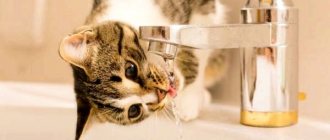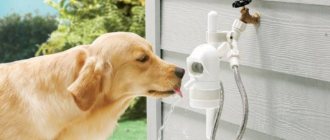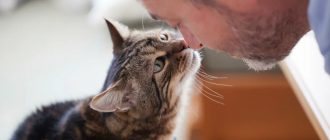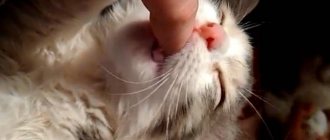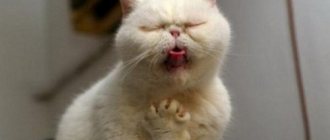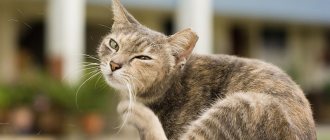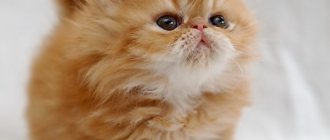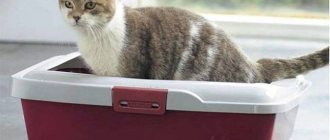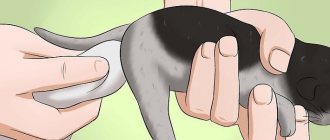Many people believe that it is impossible to force a cat to drink water, and it is not necessary. The bowl is standing - what else? If he wants, he will drink, and will not die of thirst. It is this approach that causes problems with the urinary system in urban cats.
All pets, without exception, need access to fresh water. But first of all - for those who eat dry food. As intended by Mother Nature, predators receive a lot of fluid from the blood and other components of the prey. And when kept in apartments, cats eat either bled meat or dry food, or, less often, canned food. In these conditions, owners must further stimulate interest in water. Drinking plenty of fluids helps indoor cats maintain healthy kidneys and urinary systems.
The mother cat teaches the kittens not only to eat from a bowl and visit the litter box, but also to drink water. If a person raises children, this responsibility falls on his shoulders.
Author of the article: Olga Shiltsova, practicing veterinarian, author of the books “Dachshund of Fate” and “Tails of Fortune”
Why do cats drink little water?
From a biological point of view, all domestic cats are representatives of the “steppe cat” subspecies, which exists to this day. Domestication had almost no effect on the basic behavior patterns of the small predator. Therefore, cats behave as if they still live in the desert or steppe - they try to go for a long time without a watering hole.
Cats do not like to drink, which is why their urine has such a strong smell - it is much more concentrated than that of humans or dogs. The feeling of thirst in cats is dulled; they pay much more attention to hunger.
Another reason why your pet is not getting enough fluids is an unproductive lapping mechanism. A cat can spend a lot of time at the bowl and still drink very little water.
The cat's tongue just touches the water and rushes back. The water rises in a column and the cat grabs it, closing its mouth. The tongue moves very quickly - about four movements per second.
Those at risk for insufficient moisture intake are pets kept on dry food. The moisture content in pellets is about 10%, while in raw or canned meat it is 70-80% water. A cat that eats dry food must drink significantly more water to make up the difference.
What is the problem: main reasons
If a pet drinks only milk and eats well, but constantly refuses to quench its thirst, then this does not always signal pathological conditions. Perhaps the pet simply doesn’t like water or doesn’t like the one its owners give it. And also, for example, small cats that were fed breast milk or from a nipple, and are not accustomed to drinking, may be unable to independently quench their thirst from a bowl for a month or even more. There are other reasons why a cat does not drink water:
- Low quality dishes. Owners, wanting to save money on cat products, sometimes buy very bad products, which are sometimes made of unpleasant-smelling plastic. Seals and adults often refuse to drink from such a bowl or scoop it up with their paw.
- The cat's inability to drink water from the bowl. To the surprise of people, not all pets have this skill, so sometimes it is necessary to spend time and teach the cat to drink or provide it with another source.
- Unpleasant smell of water. If a tap product is used, it may contain large amounts of chlorine. In this case, owners rarely manage to force their pet to drink. It is recommended to install a filter or use bottled water.
- Dirty bowl. If the drinking vessel is not washed on time, then the pet can quench its thirst directly from the tap and other sources.
- Pathological condition. When a cat does not eat or drink, this may be a signal of the development of a disease. If the pet is rejected, it may cause diarrhea, vomiting, weakness and other symptoms.
Veterinarians advise buying water dishes made of ceramics, since such a bowl does not have an unpleasant odor and is easy to clean.
The dangers of insufficient fluid intake
If a cat doesn't drink enough, it becomes chronically dehydrated. First of all, owners notice problems with the coat - it becomes dull and falls out. Then the urinary system suffers. The urine becomes too concentrated and the salt crystals it contains precipitate. First, “sand” is formed, and then larger stones. Urolithiasis is especially dangerous for males - sand clogs the long and thin urethra, causing urinary retention.
Water is also important for digestion. Chronic dehydration causes constipation. If your pet's poop is hard as pebbles, this is a warning sign.
When dehydrated, your blood becomes thicker and your blood pressure rises. This is especially dangerous for cats with kidney or heart failure.
Too little water...
Usually, owners think about how to get a cat to drink water precisely after the appearance of serious health problems - an attack of cystitis or urolithiasis, since such diseases return again and again.
When to see a doctor
In some cases, an animal’s refusal to drink water is due to various diseases. Associated symptoms here may be lethargy and apathy. If poisoned, the animal may suffer from diarrhea or vomiting.
Let's summarize: for full development it is important that the kitten consumes enough water. If there is a problem in getting used to drinking plain water from a bowl, it is important to understand the cause. If the baby has not yet learned the ability to drink properly from his mother, he needs to be taught how to do it. If the kitten does not like the quality of the water, it is worth observing its preferences and making the necessary changes, and in case of dehydration caused by illness, it is necessary to visit a veterinarian and undergo a course of treatment in accordance with his recommendations.
What kind of water to give your cat
The quality of tap water in cities varies greatly depending on the region. In large cities, modern treatment facilities have been installed, but at the same time, old pipes serve as a source of harmful impurities. Cats are not suitable for water with a high content of chlorine, heavy metals, fluorine, or hard water with a lot of salts. I also do not recommend giving cats boiled water - it greatly spoils the taste.
Water in a jar seems much tastier to a kitten than water in a bowl.
The best option is fresh filtered water or bottled water of good quality. Water from different sources has a different taste, so you need to experiment. Country cats happily drink rain and well water.
In pet stores you can see water specifically for pets, but to me this seems more like a marketing ploy.
The water should be fresh and changed every day (more often if the animal has problems with the urinary system). The bowl needs to be washed regularly.
How to figure out if your kitten has enough water
To understand that the animal has enough fluid for normal functioning, you need to analyze the following points:
- Condition of skin and coat . They should have a healthy appearance, without peeling or bald spots. You can pull back the kitten's scruff - with elastic skin, it will easily return to its previous position, but in a dehydrated kitten, the elasticity of the skin is lost.
- Activity . A healthy animal should be cheerful, especially in childhood.
- Frequency of urination . A healthy animal goes to the toilet 2-3 times a day. The number of approaches to the tray can be determined by how dirty it is.
What containers do cats like to drink from?
If you want to encourage your cat to drink more water, you need to choose the right bowl. It should be large: wide, deep and stable.
It is better to avoid metal and plastic utensils, as they impart a specific taste to the water. A good bowl is easy to clean and does not absorb odors. Suitable materials:
- Ceramics;
- Porcelain;
- Glass;
- Enamel.
Some cats only like to drink from tall containers. It is better for such cats to have a glass, mug or vase. You can purchase a dog bowl on a stand (height adjustable).
Drinking from a glass is a real thrill
This kitten kept turning over his water bowl, so his owner set him up with a marble mortar to drink from!
How do you know if your cat needs veterinary help?
Usually you can cope with this problem yourself; you just need to move the feeder away from the drinking bowl or change the contents of the latter more often. If your four-legged pet refuses to drink or does it too rarely, and there are other suspicious symptoms, you cannot ignore them. Such carelessness under unfavorable circumstances can cause the death of an animal. You should immediately show your cat to a veterinarian if:
- she has completely or partially lost interest in food;
- the four-legged friend's behavior has changed (he has become lethargic, apathetic, does not respond to external stimuli, spending most of his time in a lying position or, on the contrary, is restless and aggressive);
- the cat feels sick and vomits;
- your pet has diarrhea or constipation;
- the animal's body temperature has increased;
- your four-legged pet has bad breath;
- the cat is losing weight;
- there are foreign inclusions in the cat’s feces or urine in the form of mucus and blood;
- the consistency of feces has changed, they have a foul odor;
- the cat has decreased the number of urinations;
- the mucous membranes of the animal acquired a jaundiced tint.
These are just a few possible suspicious symptoms that require immediate attention to your veterinarian. A sick pet may have other warning signs.
When a kitten appears in the house, the owner is faced with many new worries. It is necessary not only to decide on feeding your furry pet, but also to monitor its upbringing and hygiene.
One of the most common problems at the initial stage is the pet’s refusal to drink fluids. If a kitten does not drink water, you need to figure out why this is happening and how to help him.
Organize the right place for a watering hole
Sometimes a cat drinks little water only because the water bowl is in the wrong place and there is no alternative.
Water should not be near food
The most common misconception among owners is to place a bowl of food and a bowl of water next to each other, or even use a double bowl. Drinking where they have eaten is not typical for cats; in nature, a watering hole is always located at a distance from the hunting area. And this instinct is still relevant: if a pellet of food or a piece of meat falls into a bowl of water, it will instantly deteriorate, becoming undrinkable. How quickly the owner will discover the problem is a big question.
Water should not stand near the tray
No comment here - neither water nor food should be near the cat's litter box. Cats are clean animals; they carefully bury their excrement, prefer to use a litter tray with fresh litter, and are disdainful of eating near their own litter box.
It's funny, but a human toilet may seem like a good source of fresh water to a cat - far from the kitchen, in a secluded place, on a hill. The danger is that the cat can be poisoned by detergents due to the owner’s oversight.
Image is nothing, thirst is everything!
There must be several sources of water
Cats are extremely sensitive to hunger, but can ignore thirst for a long time. Therefore, there should be several bowls, taking into account the size of your home - for a small apartment this is at least three watering places.
The water should be in the path of the cat's usual route. Observe where your pet likes to rest and play (woke up, drank and only then ran to eat).
A cat's laziness knows no bounds, just take it for granted that your cat will not specifically go looking for water to drink.
Water on a hill
In the wild, the higher the water, the cleaner it is. Cats strive “to the source of the river,” ignoring the water that is in a flat bowl on the floor. Sometimes it is enough to place a deep bowl on a raised surface (window sill, table) to get your pet interested in water. Many cats like to drink from the tap not because there is running water. The sink is just high enough.
Oh, water, good luck. Whatever I don’t finish, I’ll spill
If you place a drinking fountain on the floor, it will be less attractive than a water tap. It is better to place high containers on the floor: a bucket, basin, pan.
Knowing your cat's drinking habits, be careful not to leave attractive containers with toxic contents unattended:
- a bucket of cleaning liquid when washing floors;
- dishes in the sink, filled with water and dishwashing detergent;
- a basin with soaked laundry;
- a glass for rinsing brushes on the table after painting.
Bobtail drinks from a bucket
Interesting Facts
The origin of the cat is associated with its African history. It was in Egypt that these animals were revered most of all, they were looked after, kept clean, tidy, and extolled. A weakened craving for water and a feeling of thirst are associated with the remaining need for a small amount of water on a dry continent. But we know how important it is for a cat to drink. Therefore, you need to replace your water balance through drinking or eating.
Every owner wants their cat to be healthy. Satisfying the daily need for water (1.5-2 times more than food intake, especially if it is dry food) helps normalize metabolic processes, prevent stagnation and possible infections of the genitourinary system. Cats love to drink water from fountains, so if your pet actively asks for water from the tap, you can buy such a device for him.
Sometimes cats drink liquids from non-standard containers, such as a bucket, sink or mug. If you have the opportunity to give your pet such a drinking item, fill it with more water and place it in an accessible place. In summer, you can take a wide bowl and leave it on the balcony.
4 more tricks to get your cat to drink water
Suppose you have already placed salad bowls and vases with fresh water throughout the house, but the cat stubbornly ignores the watering hole. Well, there are a few more tricks, one of which will definitely work.
Flavor the water
If the cat is indifferent to ordinary water, you can play on food interest. To do this, pets are offered various solutions or added to the water for scent:
- Meat juice is a dark liquid that remains in a bowl after raw meat or offal, especially a lot of it is released when defrosting.
- Unsalted broth - just boil a couple of shrimp, crayfish, shellfish (mussels, oysters) in water without salt. If your cat doesn’t like seafood (although they usually enjoy it), add a little bone or meat broth to the water.
- A drop of milk or a pinch of cat milk replacer (sold in pet stores and veterinary pharmacies).
- Soak slices of fresh cucumber in water – some cats are attracted to “vegetable water”.
- Fortiflora is a commercial probiotic supplement for cats. Available in powder form, it has a distinct meaty smell. Just add a pinch to the water.
- Viyo Reinforces is a prebiotic for cats in the form of a nutritious drink, can be given in pure form, or can be diluted with water in various proportions (1:1, 1:2) - this way the cat will receive even more fluid.
The only disadvantage of “tasty water” is that it spoils quickly; it cannot be left in a bowl for the whole day.
Some cats love to drink earthen water - the kind that accumulates in the saucer of a flower pot after abundant watering. Others tend to eat from the aquarium. Do not scold your pets, but try to provide them with a “favorite watering hole.”
Mmmm, yummy
Running water
The sound of water attracts cats, sometimes it is curiosity and a desire to play, but in the end the cat still drinks the water, even if it is licking its wet paws. Running water naturally seems fresher to animals than standing water, which is why cats love to drink from the tap.
Many cats prefer to drink straight from the tap.
Try giving your pet a special fountain. There are different models in the form of a stream or a falling jet (faucet, chamomile).
Ice cubes
Settled water is at room temperature, and warm water is not as tasty as cool water. Cold water is associated with freshness, so it's a good idea to keep your cat's water cold throughout the day, change it frequently, and keep a bottle of water in the refrigerator in the summer.
An ice cube placed in a bowl of water can have a good effect. Playful cats begin to touch and chase the mysterious object with their paws, try to get it, and lick it. Plus, the water in the bowl does not heat up so quickly - this is important if you are at work all day.
You might be surprised, but many cats love to play with pieces of ice.
You can freeze not just water, but meat juice or shrimp broth.
Toy floating in water
For kittens and young cats, a toy floating on the surface of the water will be a good “lure”. Place a basin or pan on the floor and throw in a small light ball (for example, a ping pong ball or a Kinder Surprise egg), a bottle cap, a plastic cap. While chasing and trying to get the toy, the kitten will dip its paws in the water and then lick them. This is how the pet learns to be interested in water.
How to choose?
If the cat does not drink water or, having drunk it, looks for another source to quench its thirst, then the owners should pay attention to the quality of the product. A clean liquid without a strong odor is suitable for drinking for feline pets. The bowl is located in an accessible room; you should not place it in the toilet or bathroom where the doors are closed. Regular water changes are important as they stagnate quickly. It is worth constantly cleaning and cleaning all containers from which your pet eats and drinks. It would be more convenient for people to teach their cat to drink liquid from the tap, but they should not do this, since it contains a lot of chlorine, which will affect the pet’s condition.
